net culture
- Aaaaarg
- Robert Adrian X
- AHA
- Aksioma
- Clemens Apprich
- Are.na
- Inke Arns
- Art Servers Unlimited
- Artnode
- Backspace
- Richard Barbrook
- Dušan Barok
- Aram Bartholl
- Tatiana Bazzichelli
- Beauty and the East
- BEK
- Z. Blace
- Joachim Blank
- Josephine Bosma
- Andreas Broeckmann
- Ted Byfield
- C-base
- C3
- Community servers
- Vuk Ćosić
- Florian Cramer
- Walter van der Cruijsen
- CRUMB
- Annet Dekker
- Digital activism
- De Digitale Stad
- Disruption Network Lab
- Sher Doruff
- Constant Dullaart
- -empyre-
- Sandra Fauconnier
- Fediverse
- File sharing
- Rasmus Fleischer
- The Flying Desk
- Luka Frelih
- Matthew Fuller
- David Garcia
- Jan Gerber
- Kenneth Goldsmith
- Olga Goriunova
- Johannes Grenzfurthner
- Hacker culture
- Handshake
- Heath Bunting
- The Hmm
- Brian Holmes
- Kathy Rae Huffman
- Hybrid Workspace
- Adam Hyde
- Institute of Network Cultures
- Internationale Stadt Berlin
- Irational.org
- Karl Heinz Jeron
- Jodi
- Kein.org
- Eric Kluitenberg
- Kuda.org
- LI-MA
- Ljudmila
- Geert Lovink
- Alessandro Ludovico
- Sebastian Lütgert
- LURK
- MaMa
- Aymeric Mansoux
- Marcell Mars
- Diana McCarty
- Tomislav Medak
- Media culture mailing lists
- !Mediengruppe Bitnik
- Armin Medosch
- MetaForum
- Mikro
- Monochrom
- Monoskop
- Multiplace
- Mur.at
- Mute
- Net art
- Net.Congestion
- Net.Radio Days
- NetBehaviour
- Nettime
- Caroline Nevejan
- Next 5 Minutes
- Netochka Nezvanova
- Old Boys Network
- Panke.gallery
- Piratbyrån
- The Pirate Bay
- Public Library / Memory of the World
- Public Netbase/t0
- Domenico Quaranta
- Readme
- Rhizome
- RIXC
- Rohrpost
- Runme.org
- Sakrowski
- Pit Schultz
- Servers
- Servus.at
- Shadow libraries/2025
- Cornelia Sollfrank
- Spectre
- Wolfgang Staehle
- Felix Stalder
- Station Rose
- Marleen Stikker
- Lilian Stolk
- Igor Štromajer
- János Sugár
- Surf clubs
- Syndicate
- Valentina Tanni
- Textz.com
- THE THING
- Tommaso Tozzi
- UbuWeb
- V2
- Valie Djordjevic
- Varia
- Virtueel Platform
- Waag
- McKenzie Wark
- WELL
- Wikis
- Xchange
- XPUB
- Your World of Text
log[edit]
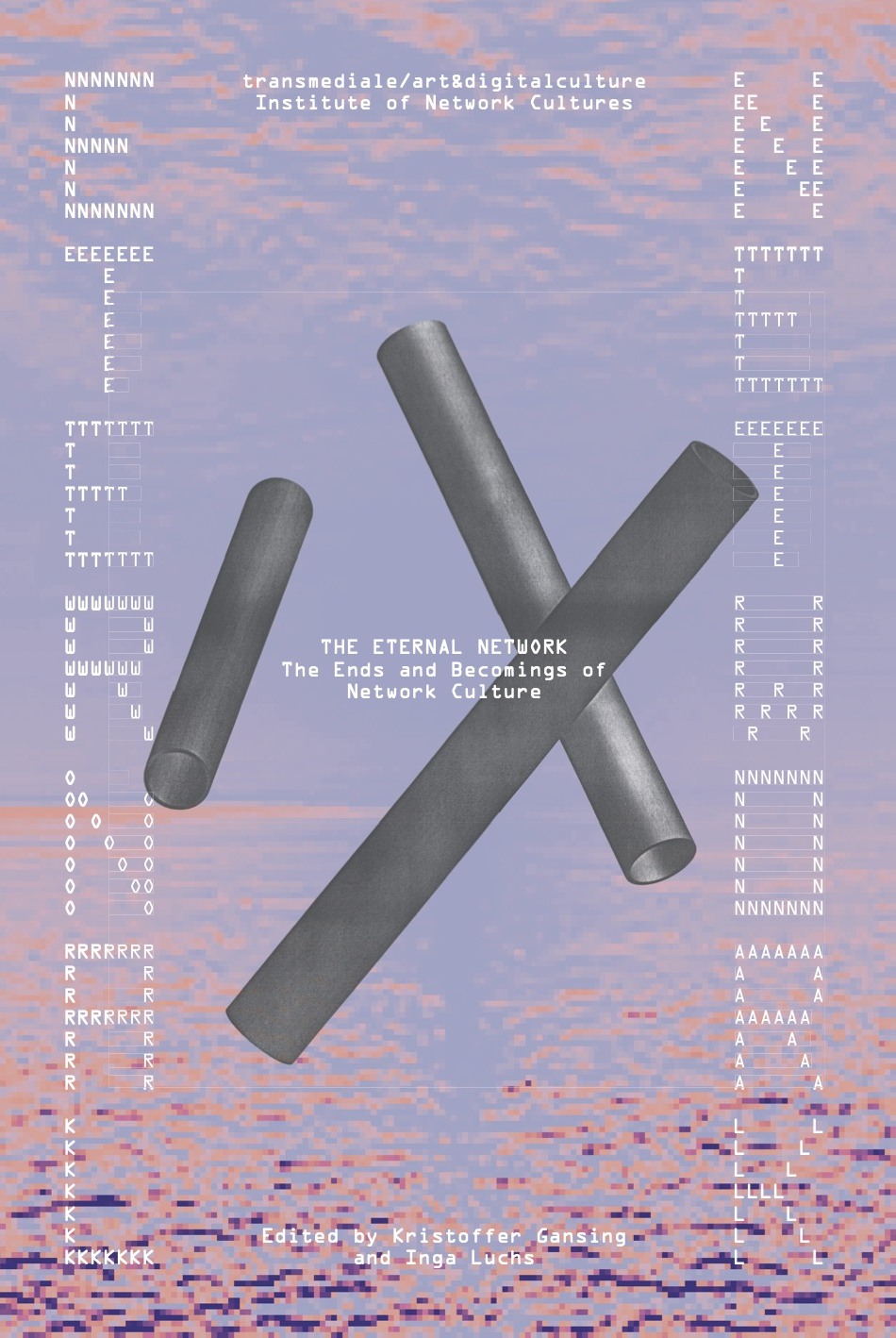
“‘The network is everlasting’ wrote Robert Filliou and George Brecht in 1967, a statement that, at first glance, still seems to be true of today’s world. Yet there are also signs that the omnipresence of networks is evolving into another reality. In recent times, the limits of networks rather than their endless possibilities have been brought into focus. Ongoing media debates about hate speech, fake news, and algorithmic bias swirl into a growing backlash against networks. Perhaps it is time to reconsider the contemporary reach and relevance of the network imaginary.
Accompanying transmediale 2020 End to End’s exhibition ‘The Eternal Network’, this collection gathers contributions from artists, activists, and theorists who engage with the question of the network anew. In referencing Filliou’s eternal notion, the exhibition and publication project closes the loop between pre- and post-internet imaginaries, opening up possible futures with and beyond networks. This calls many of the collection’s authors to turn to instances of independent and critical net cultures as historical points of inspiration for rethinking, reforming, or refuting networks in the present.”
Contributors: Clemens Apprich, Johanna Bruckner, Daphne Dragona, Kristoffer Gansing, Lorena Juan, Aay Liparoto, Geert Lovink, Alessandro Ludovico, Aymeric Mansoux, Rachel O’Dwyer, Luiza Prado de O. Martins, Roel Roscam Abbing, Femke Snelting, and Florian Wüst.
Publisher Institute of Network Cultures, Amsterdam, and transmediale e.V., Berlin, 2020
Creative Commons BY-NC-ND 4.0 International License
ISBN 9789492302465
145 pagesEnglish: PDF, PDF (14 MB), EPUB, EPUB (18 MB), HTML (partial, added on 2020-7-16)
German: PDF, PDF (9 MB, added on 2020-12-4)
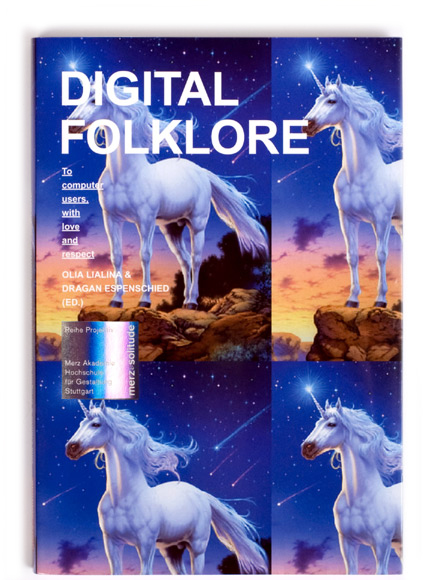
“Technical innovations shape only a small part of computer and network culture. It doesn’t matter much who invented the microprocessor, the mouse, TCP/IP or the World Wide Web and what ideas were behind these inventions. What matters is who uses them. Only when users start to express themselves with these technical innovations do they truly become relevant to culture at large.
Users’ endeavors, like glittering star backgrounds, photos of cute kittens and rainbow gradients, are mostly derided as kitsch or in the most extreme cases, postulated as the end of culture itself. In fact this evolving vernacular, created by users for users, is the most important, beautiful and misunderstood language of new media.
As the first book of its kind, this reader contains essays and projects investigating many different facets of Digital Folklore: online amateur culture, DIY electronics, dirtstyle, typo-nihilism, memes, teapots, penis enlargement, …” (from the back cover)
Contributors: Cory Arcangel, Julia Böger, Manuel Buerger, Helene Dams, Dragan Espenschied, Jörg Frohnmayer, Mark Grimm, Christopher Heller, Yunchul Kim, Dennis Knopf, Stefan Krappitz, Florian Kröner, Tobias Leingruber, Olia Lialina, Leo Merz, Bernadette Neuroth, o+ro, johannes p osterhoff, Isabel Pettinato, Michael Ruß, Alexander Schlegel, Bert Schutzbach, Siegfried Zielinski.
Publisher Merz & Solitude (Merz Akademie & Akademie Schloss Solitude), Stuttgart, 2009
Reihe Projektiv series
Designer Manuel Buerger
ISBN 9783937982250, 3937982256
287 pagesReviews: Pau Waelder (Furtherfield, 2010), Kevin McGarry (Rhizome, 2010), Regine Debatty (We Make Money Not Art, 2010), Alessandro Ludovico (Neural, 2010), Richard Schwarz (The Gap, 2010, DE), Marie Lechner (Libération, 2010, FR), Stefania Bercu (Masters of Media, 2010).
Book website
Publisher
WorldCatPDF (27 MB)

“Mitte der 1990er Jahre ist in Europa eine vielfältige Netzkultur entstanden. Während die US-amerikanische Szene den Cyberspace als Raum jenseits der Politik imaginierte, waren die europäischen Netzpioniere darauf bedacht, die Möglichkeiten des Internet für neue politische und kulturelle Initiativen in der realen Gesellschaft zu nutzen.
Anhand von Zeitdokumenten, aktuellen Textbeiträgen und Interviews geht dieser Band erstmals auf die kritische Haltung europäischer Netzkulturen ein. Die Beiträge liefern so wichtige Referenzpunkte zur Gestaltung unserer techno-kulturellen Gegenwart jenseits von Facebook und Google.”
Publisher transcript, Bielefeld, 2012
Kultur- und Medientheorie series
ISBN 9783837619065, 3837619060
348 pages
via ResearchGateInterview with editor: Vera Tollmann (Springerin, 2013).
Reviews: Verena Pizzini (kulturrisse, 2012), Leonhard Dobusch (Netzpolitik, 2012), Werner Reiter (The Gap, 2012), Martin Schmitt (sehepunkte, 2013).
Proud to be Flesh: A Mute Magazine Anthology of Cultural Politics after the Net (2009)
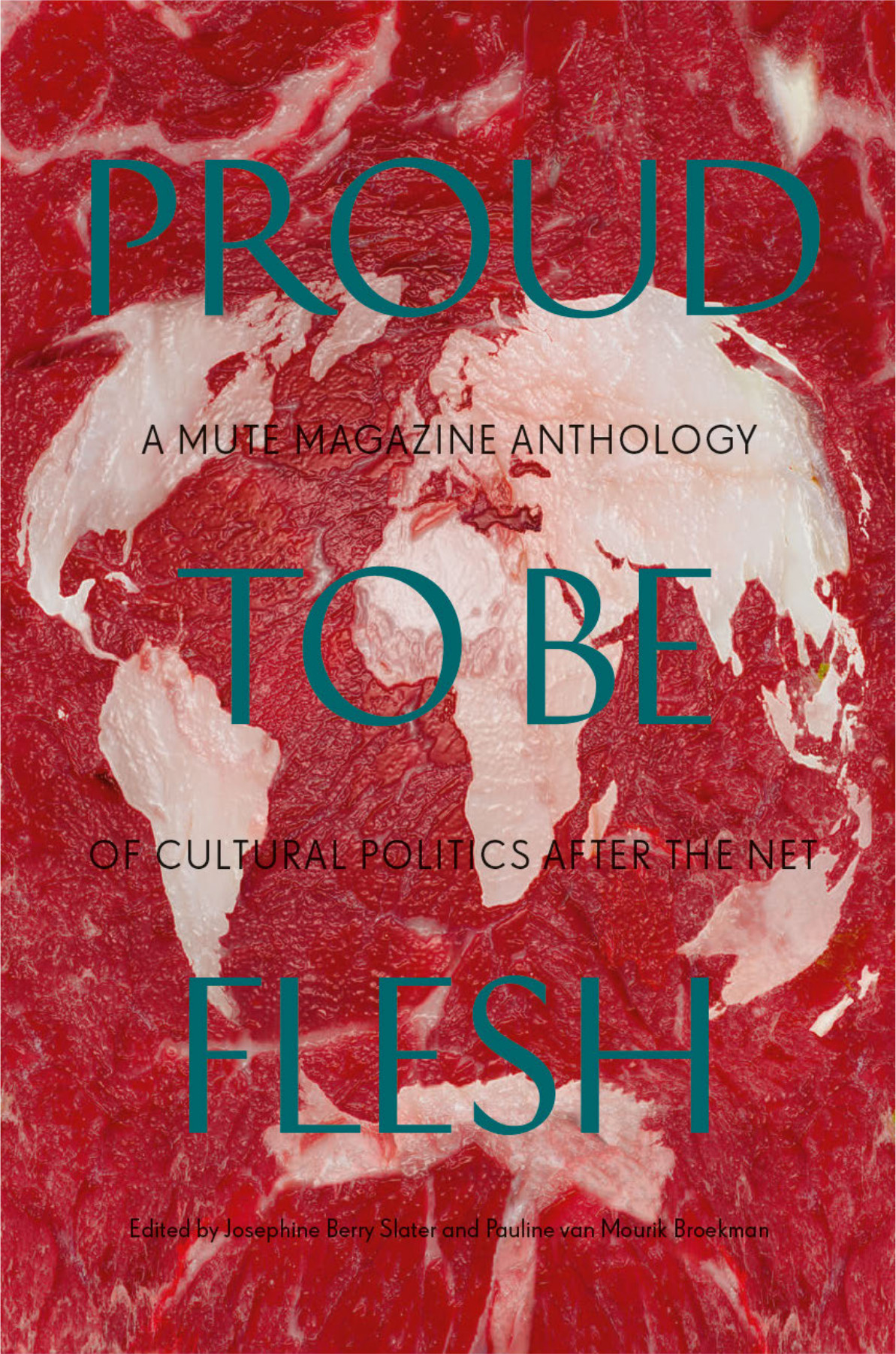
“In late 1994, back in the days of dial-up modems and Netscape Navigator 1.0, Mute magazine announced its timely arrival. Dedicated to an analysis of culture and politics ‘after the net’, Mute has consistently challenged the grandiose claims of the communications revolution, debunking its utopian rhetoric and offering more critical perspectives.
Fifteen years on, this anthology selects representative articles from the magazine’s hugely diverse content to reprise some of its recurring themes. This expansive collection charts the perilous journey from Web 1.0 to 2.0, contesting the democratisation this transition implied and laying bare our incorporeal expectations; it exposes the ways in which the logic of technology intersects with that of art and music and, in turn and inevitably, with the logic of business; it heralds the rise of neoliberalism and condemns the human cost; it amplifies the murmurs of dissent and revels in the first signs of collapse. The result situates key – but often little understood – concepts associated with the digital (e.g. the knowledge commons, immaterial labour and open source) in their proper context, producing an impressive overview of contemporary, networked culture in its broadest sense.
Proud to be Flesh features a mix of essays, interviews, satirical fiction, email polemics and reportage from an array of international contributors working in art, philosophy, technology, politics, cultural theory, radical geography and more.”
Edited by Josephine Berry Slater and Pauline van Mourik Broekman, with Michael Corris, Anthony Iles, Benedict Seymour and Simon Worthington
Publisher Mute Publishing, London, with Autonomedia, New York, 2009
ISBN 9781906496289, 1906496285
572+48 pagesReviews: Nicholas Thoburn (New Formations), Charlotte Frost (Rhizome), Julian Stallabrass (New Left Review).
monochrom, 11-23 (2000-2004) [German]


The mouthpiece of an international art-technology-philosophy collective founded in 1993, with its headquarters at Museumsquartier in Vienna.
“Das Fanzine monochrom ist ein im Telefonbuch-Format erscheinendes Zeitschriftenobjekt, das von der gleichnamigen Künstler_innengruppe aus Wien, Graz und Bamberg/Deutschland herausgegeben wird. monochrom ist ein Potpourri der digitalen und analogen Subversion, ein unnostalgisches Amalgam aus 125 Jahren abendländischer Gegenkultur, die Godzilla-Variante der gutbügerlichen Coffeetablebuch-Idee.”
Editor-in-chief: Johannes Grenzfurthner
Publisher monochrom, Vienna
ISSN 1024-6738Publisher, (2)
monochrom on WikipediaPDF (No. 11-14: Ontologisches Sanierungsportfolio, 2000, 260 pp)
PDF (No. 15-23: Zweite Ordnung muss sein, 2004, 436 pp)
Tomislav Medak, Petar Milat (eds.): Idea of Radical Media (2013) [English/Croatian]
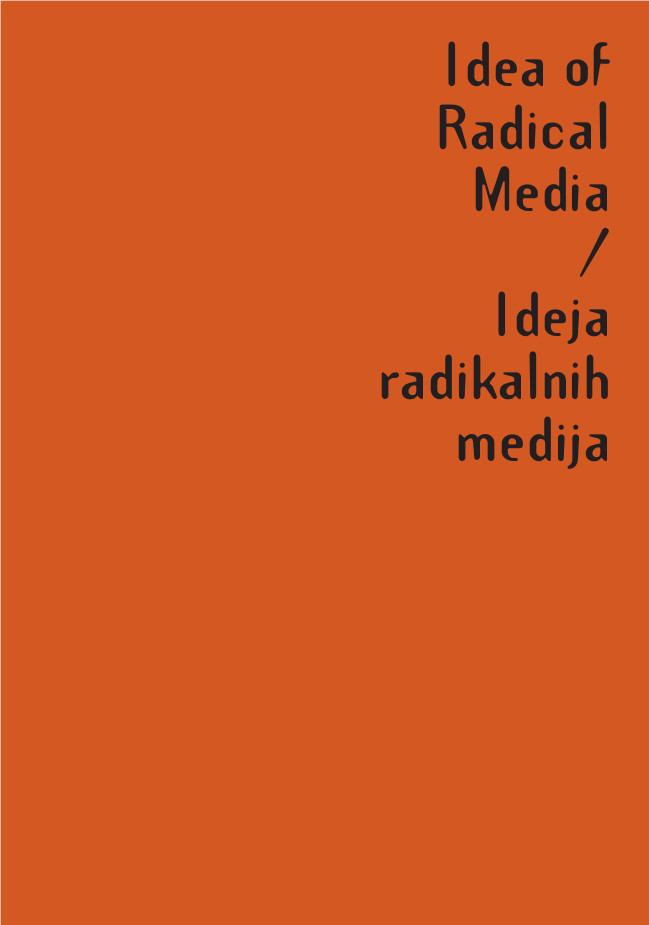
This is the “reader from the Idea of Radical Media conference, held June 7-8, 2013 in Zagreb, Croatia, and organized by the Multimedia Institute. The conference took place in the context of the exhibition Prospects of Arkzin and the media action Installing the Public, both revisiting the Arkzin phenomenon two decades later. Arkzin was a collective and a publication that emerged out of the Anti-War Campaign in the early 1990s and gave a theoretical and polemical voice to anti-nationalist positions. The publishing and activist practices of Arkzin anticipated and reflected the practices of tactical media that were crystallizing from a particular confluence of a political moment marked by the post-socialist transition, post-Yugoslav conflicts and alter-globalist contestations, and a technological moment of the rise of early Net.
However, the conference and the reader have a broader aim. On the one hand, we wanted to look back at the practical articulations and discursive re-articulations of radical media practices in arts, mass communication and political work and over the last two decades. On the other, to reasses the notion of radical media from a broader historical perspective and the critical perspective of the current political moment.” (from the Introduction)
With essays by Clemens Apprich, Eric Kluitenberg, Jodi Dean, Matteo Pasquinelli, Branka Ćurčić, Alessandro Ludovico, Anthony Iles, Joanne Richardson, Vera Tollmann, Katarina Peović Vuković and Ana Peraica.
Idea of Radical Media / Ideja radikalnih medija
Publisher Multimedia Institute, Zagreb, 2013
ISBN 9789537372101
256 pagesPDF
See also Prospects of Arkzin catalogue (48 pp, 2013)
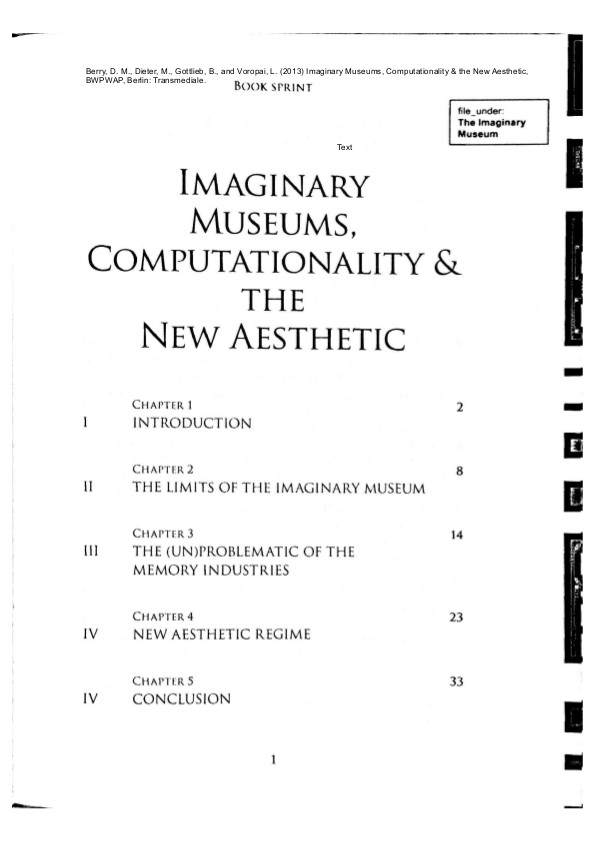
“This text was produced in a four-day long process of collaborative writing, a so called book sprint, facilitated by Adam Hyde through the Booktype software and featuring writers David M. Berry, Michael Dieter, Baruch Gottlieb and Lioudmila Voropai. The instructions were to write an essay on the relationship between the netculture meme, The New Aesthetic and The Imaginary Museum, as an art world meme. Following this intense and extremely creative writing process, a work of approximately 12,000 words was produced as a contribution to the file_under: The Imaginary Museum informing transmediale 2013.” (Source)
Self-published in Berlin, January 2013
41 pages
via anonymousPDF (no OCR)
monochrom, 3-10 (1994-1998) [German]

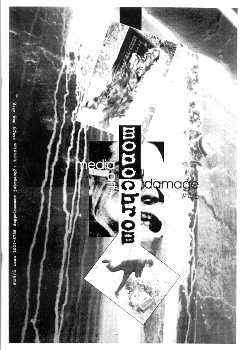
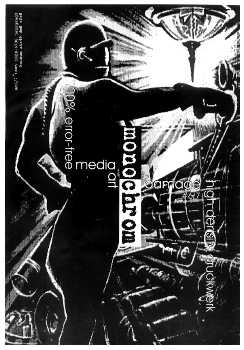
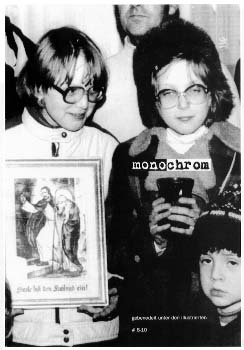
The mouthpiece of an international art-technology-philosophy collective founded in 1993, with its headquarters at Museumsquartier in Vienna.
Editor-in-chief: Johannes Grenzfurthner
Publisher Monochrom, Vienna
ISSN 1024-6738Authors
Monochrom on WikipediaPDF (No. 3: media dings, 1994/95, 68 pp)
PDF (No. 4-5: media art damage, 1995/96, 104 pp)
PDF (No. 6-7: 100% error free high-density druckwerk, 1997, 112 pp)
PDF (No. 8-10: gebenedeit unter den illustrierten, 1998, 180 pp)
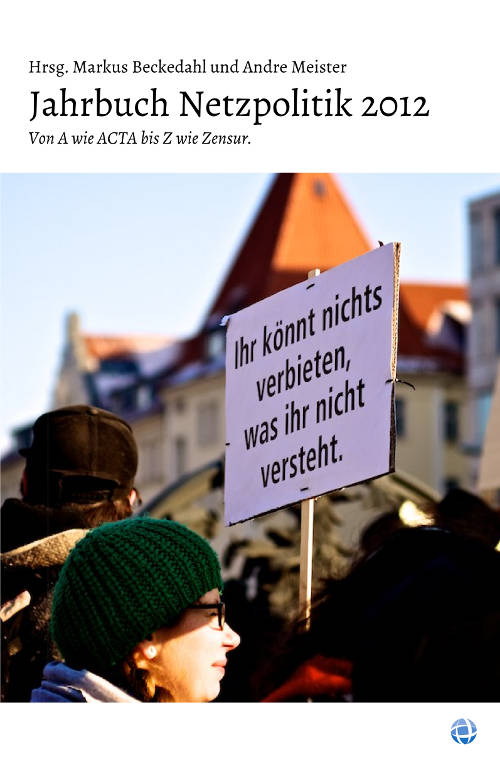
Netzpolitik betrifft alle, jede und jeden. Was im Jahr 2012 wichtig war, was vielleicht auch zu kurz kam, darauf blickt dieses Jahrbuch zurück. Die Autorinnen und Autoren waren Beobachter und Akteur zugleich.
Ihre Berichte in diesem Buch fassen die wichtigsten Themen des Jahres zusammen, ordnen ein und reflektieren.
Von A wie ACTA und Anonymous über Open-Data und Überwachung bis zu Urheberrecht und Z wie Zensur: komprimiert, informiert und frei lizenziert.
Mit Beiträgen von: Jan-Phillip Albrecht, Markus Beckedahl, Annegret Bendiek, Mirko Boehm, Jörg Braun, Ulf Buermeyer, Gabriella Coleman, Leonhard Dobusch, Kirsten Fiedler, Karina Fissguss, Kilian Froitzhuber, Volker Grassmuck, Johnny Haeusler, Christian Heise, Jeanette Hofmann, Jōichi ‘Joi’ Itō, Andrea Jonjic, Matthias Kirschner, Julia Kloiber, Constanze Kurz, Lawrence Lessig, Falk Lüke, Lorenz Matzat, Tim Maurer, Joe McNamee, Andre Meister, Matthias Monroy, John F. Nebel, Frank Rieger, Alexander Sander, Ben Scott, Felix Stalder, Moritz Tremmel, Ben Wagner, Stefan Wehrmeyer und Jillian C. York.
Publisher Netzpolitik.org, December 2012
Creative Commons BY-SA 3.0 Germany License
ISBN 9783844242348
270 pages
via @BiellaColeman
The New Aesthetic was a design concept and netculture phenomenon launched into the world by London designer James Bridle in 2011. It continues to attract the attention of media art, and throw up associations to a variety of situated practices, including speculative design, net criticism, hacking, free and open source software development, locative media, sustainable hardware and so on. This is how we have considered the New Aesthetic: as an opportunity to rethink the relations between these contexts in the emergent episteme of computationality. There is a desperate need to confront the political pressures of neoliberalism manifested in these infrastructures. Indeed, these are risky, dangerous and problematic times; a period when critique should thrive. But here we need to forge new alliances, invent and discover problems of the common that nevertheless do not eliminate the fundamental differences in this ecology of practices. In this book, perhaps provocatively, we believe a great deal could be learned from the development of the New Aesthetic not only as a mood, but as a topic and fix for collective feeling, that temporarily mobilizes networks. Is it possible to sustain and capture these atmospheres of debate and discussion beyond knee-jerk reactions and opportunistic self-promotion? These are crucial questions that the New Aesthetic invites us to consider, if only to keep a critical network culture in place.
New Aesthetic New Anxieties is the result of a five day Book Sprint organized by Michelle Kasprzak and led by Adam Hyde at V2_ from June 17–21, 2012.
Facilitated by: Adam Hyde
Authors: David M. Berry, Michel van Dartel, Michael Dieter, Michelle Kasprzak, Nat Muller, Rachel O’Reilly and José Luis de Vicente.
Published in Rotterdam, June 2012new-aesthetic.tumblr.com (James Bridle’s Tumblr site)
sprint host
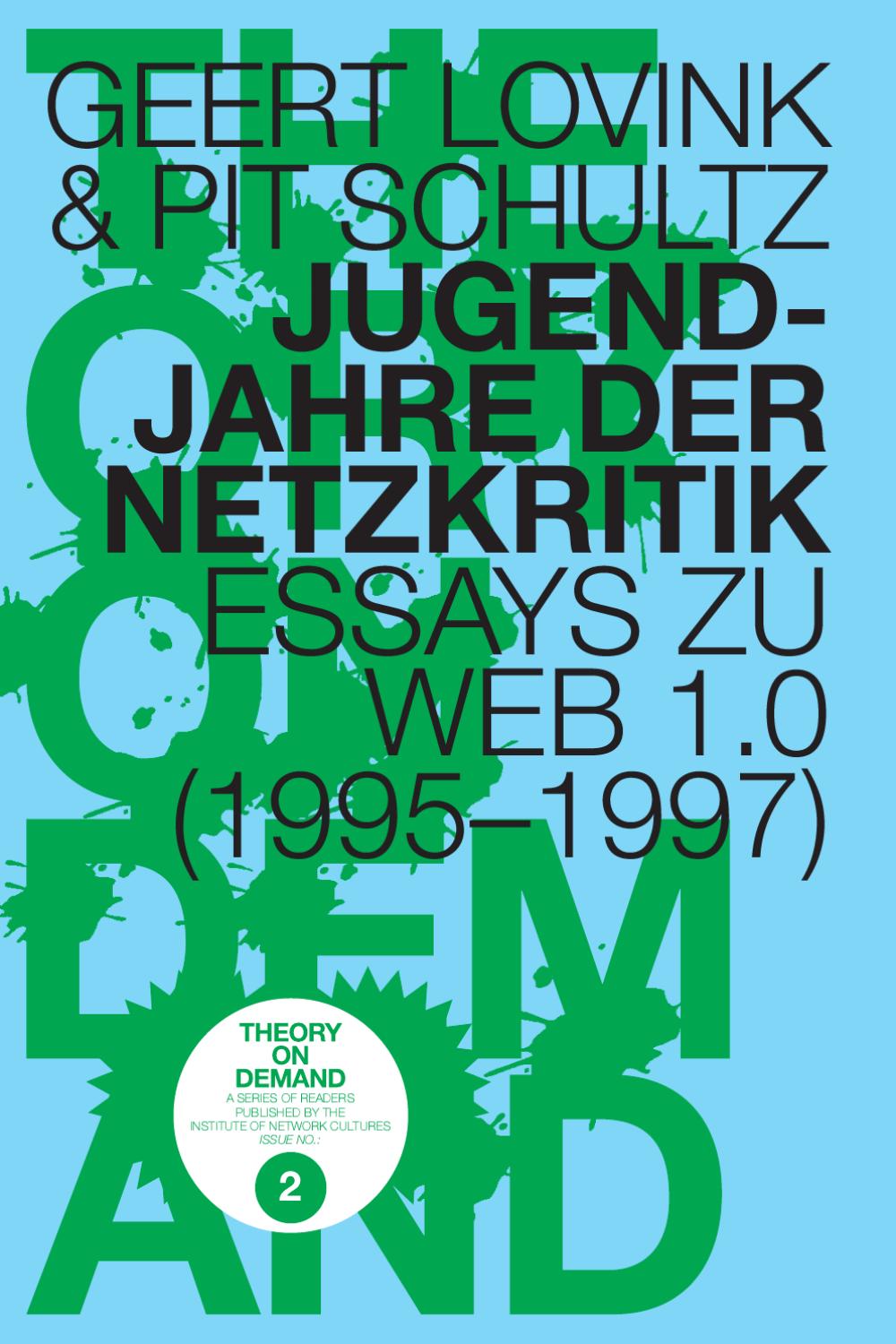
“Dieses PDF / Print-on-Demand-Heft bringt eine Auswahl der Texte zusammen, in denen die Medientheoretiker und nettime-Gründer Pit Schultz und Geert Lovink zwischen 1995 und 1997 gemeinsam die Grundzüge des Konzepts der Netzkritik formulierten. Damals auf deutsch in verstreuten Publikationen erschienen und zwischenzeitlich weitgehend in Vergessenheit geraten, werden sie nun erstmals gesammelt veröffentlicht. Sie eröffnen einen Blick auf die frühe Phase der Entwicklung des Internets und die beginnende kritische Debatte, die durch eine besondere Diskussions- und Spekulationsfreude geprägt war. Das Internet stellte noch keine allgegenwärtige Realität dar, aber sein zukünftiges Potential war schon absehbar. Im Zentrum dieser Texte steht die Kritik der damaligen Cyberutopien, die die Grundlage für die spätere Dotcom-Manie schafften. Weitere Schwerpunkte sind die Kunstpraxis (net.art), die Deutsche Medientheorie und Gegenöffentlichkeit (taktischen Medien).”
Editorial support: Andreas Kallfelzslation
Publisher Institute of Network Cultures, Amsterdam, 2010
Creative Commons BY-NC-ND 3.0 Netherlands License
Theory on Demand series, 2
ISBN 9789081602143
ReadMe! ASCII Culture & The Revenge of Knowledge. Filtered by Nettime (1999)
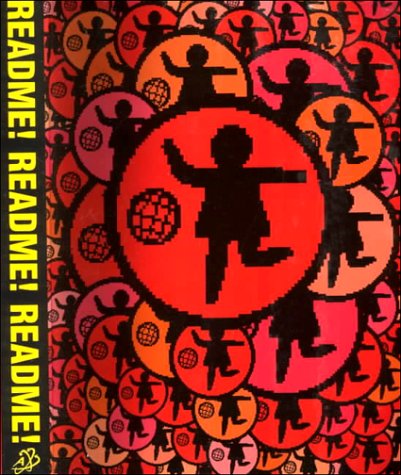
“A compilation of writings and debates from the Nettime newsgroup and internet mailing list. This book documents the debates over emerging media technologies that are currently reshaping society. What are the liberatory potentials? Where are the points of political conflict and class struggle in this new culture? What are the pitfalls of new technology? Read Me! provides the beginnings of this discussion and an outline for what has become a continuing forum on the Net.”
Edited by Josephine Bosma, Pauline van Mourik Broekman, Ted Byfield, Matthew Fuller, Geert Lovink, Diana McCarty, Pit Schultz Felix Stalder, McKenzie Wark, and Faith Wilding
Publisher: Autonomedia, February 1999
ISBN: 1570270899, 978-1570270895
556 pagessingle PDF (added on 2014-8-29, updated on 2022-12-3)
PDF chapters (updated on 2016-5-15)
Tatiana Bazzichelli: Networking: The Net as Artwork (2006/2008) [IT, EN]
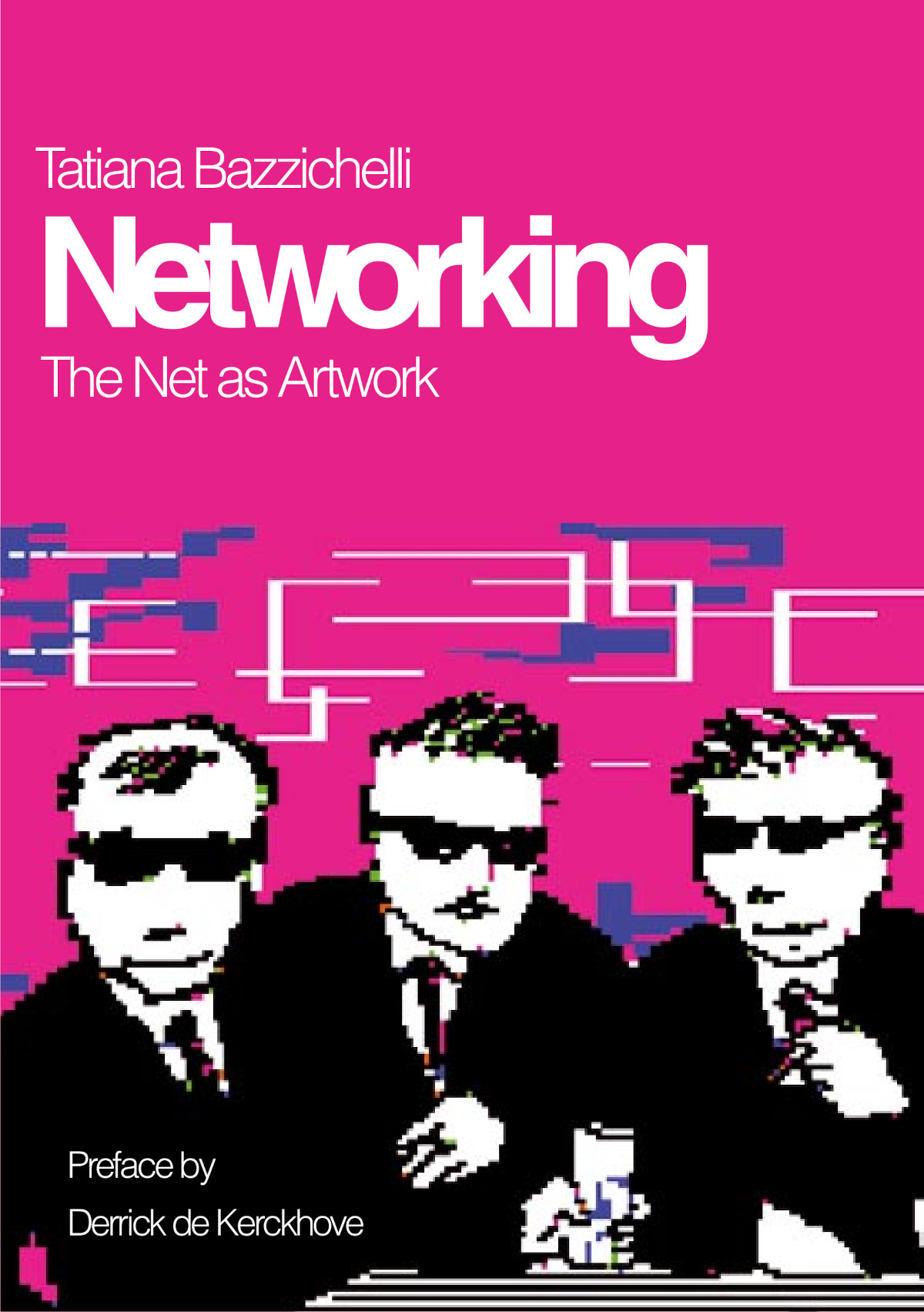
“A reconstruction of the history of artistic networking in Italy and of the Italian hacker communitiy from the 1980s to date.
Networking means to create nets of relations, where the publisher and the reader, the artist and the audience, act on the same level. The book represents a first tentative reconstruction of the history of artistic networking in Italy, through an analysis of media and art projects which during the past twenty years have given way to a creative, shared and aware use of technologies, from video to computers, contributing to the creation of Italian hacker communities.
The Italian network proposes a form of critical information, diffused through independent and collective projects where the idea of freedom of expression is a central theme. In Italy, thanks to the alternative use of Internet, during the past twenty years a vast national network of people who share political, cultural and artistic views has been formed.
The book describes the evolution of the italian hacktivism and net culture from the Eighties till today. At the same time, it builds a reflection on the new role of the artist and author who become networker, operating in collective nets, reconnecting to Neoavant-garde practices of the 1960s (first and foremost Fluxus), but also Mail art, Neoism and Luther Blissett.
A path which began in BBS, alternative web platforms diffused in Italy through the 1980s even before Internet even existed, and then moved on to Hackmeetings, to Telestreet and networking art of different artists such as 0100101110101101.ORG, [epidemiC], Jaromil, Giacomo Verde, Giovanotti Mondani Meccanici, Correnti Magnetiche, Candida TV, Tommaso Tozzi, Federico Bucalossi, Massimo Contrasto, Mariano Equizzi, Pigreca, Molleindustria, Guerriglia Marketing, Sexyshock, Phag Off and many others.”
Networking. La rete come arte
Preface by Derrick de Kerckhove
Postface by Simonetta Fadda
Publisher Costa & Nolan, Milan, 2006
Creative Commons Attribuzione-Noncommerciale-Condividi allo stesso modo 2.5 Italia
ISBN 8874370474, 9788874370474
333 pagesEnglish edition
Preface by Derrick De Kerckhove
Afterword by Simonetta Fadda
Publisher DARC, Digital Aesthetics Research Center of Aarhus University, 2008
GNU Free Documentation License, Version 1.3, November 2008
336 pagesNetworking. La rete come arte (Italian, 2006, 4 MB, added on 2016-2-19)
Networking. The Net as Artwork (English, 2008, PDF, 3 MB)